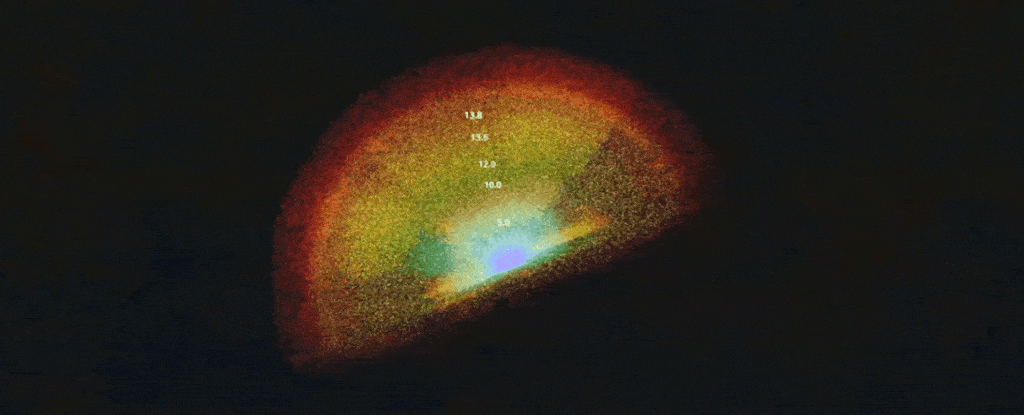A comprehensive analysis of the largest 3D map of the universe ever created has been released as part of
This video was created by the Perimeter Institute incollaboration with SDSS. Additional footage was provided by SDSS; EPFL and SDSS; Eva-Maria Mueller (University of Oxford) and SDSS Collaboration; and Zosey Rostomyan, National Laboratory named after Lawrence Berkeley.
This is a description of the cosmic distribution of moretwo million galaxies and quasars, covering almost the entire history of the Universe, is the result of many years of efforts by a large international team of scientists.

The new 3D map and its analysis not only expand our understanding of the history and structure of the universe. They also provide a framework that can foster new discoveries.
Courtesy: SDSS Collaboration
The observations were made at the Apache Point Observatory in New Mexico.
Scientists know ancient history well enoughThe universe, and the recent history of its expansion, but in the middle of 11 billion years, there is a serious gap. For five years, researchers have been working to fill this gap.
 The SDSS map is shown as a rainbow of colors in the observable universe (outer sphere showing fluctuations in the cosmic microwave background).
The SDSS map is shown as a rainbow of colors in the observable universe (outer sphere showing fluctuations in the cosmic microwave background).
We are at the center of this map. The inset for each color-coded map patch includes a typical galaxy or quasar image from that section, as well as a template signal that the eBOSS team is measuring there. When we look into the distance, we look back in time. Thus, the location of these signals indicates the rate of expansion of the Universe at different periods of cosmic history.
Photo courtesy ofAnand Raichur (EPFL), Ashley Ross (Ohio State University) and SDSS Collaboration
Scientists know what the universe looked like inrudimentary, thanks to thousands of scientists around the world who measured the relative abundance of elements created shortly after the Big Bang and who studied the cosmic microwave background. Researchers also know the history of its expansion over the past several billion years from galaxy maps and distance measurements, including from previous phases of the SDSS.
Data Taken Together - Detailed Map AnalysiseBOSS and earlier SDSS experiments now provide the most accurate measurements of expansion history over the widest range of cosmic time. These studies allow scientists to connect all the old and new dimensions into the complete history of the expansion of the universe.
The video was created by the Perimeter Institute incollaboration with SDSS. Additional footage was provided by SDSS; Anand Raichur (EPFL), Ashley Ross (Ohio State University) and SDSS; and Zosia Rostomyan, National Laboratory named after Lawrence Berkeley.
Close examination of the cardthreads and voids are found that have defined structure in the universe since it was only about 300,000 years old. In this map, researchers measure patterns in the distribution of galaxies that provide several key parameters of the universe with an accuracy of 1%.
The 3D map represents a collaboration— more than 20 years of mapping the Universe using the Sloan Foundation telescope. The cosmic history that was demonstrated on this map shows that about 6 billion years ago, the expansion of the Universe began to accelerate. Since then it has continued to accelerate and accelerate. It appears to be related to a mysterious, invisible component of the universe called "dark energy," which is consistent with Einstein's theory of general relativity but is extremely difficult to reconcile with our current understanding of particle physics.
Courtesy of:EPFL
Combining eBOSS Observations with ResearchThe universe in its infancy reveals cracks in this picture of the universe. In particular, the eBOSS team's measurement of the current expansion rate of the Universe (the "Hubble Constant") is about 10% lower than the value obtained by tracking distances to nearby galaxies. The high accuracy of eBOSS data means that it is unlikely that this discrepancy is due to chance, and the wide variety of eBOSS data gives us several independent ways to draw the same conclusion.
Only with maps like ours can you safely say there is a mismatch in the Hubble constant. These latest maps from eBOSS show it more clearly than ever before.
Eva-Maria Müller, University of Oxford
There is no generally accepted explanation for this discrepancy inmeasured expansion rates, but one exciting possibility is that a previously unknown form of matter or energy from the early universe could have left a mark on our history. As scientists assured, the new map of the Universe is already beginning to present surprises and surprised scientists.
The eBOSS team has separate groups of universities foraround the world focused on various aspects of the analysis. The team used large red galaxies to create a section of the map that is six billion years old. Then they used young blue galaxies. Finally, to map the universe over 11 billion years or more, they used quasars - bright galaxies illuminated by material striking the central supermassive black hole. Each of these samples requires careful analysis in order to identify the patterns of the universe.
In total, the eBOSS team has releasedresults of more than 20 scientific works. Over 500 pages of these documents, the team analyzes the latest data from eBOSS, highlighting the achievement of the main objectives of the study.
The SDSS is far from completing its mission to map the universe. Karen Masters, spokeswoman for the current SDSS phase, spoke about her excitement about the next phase.
The Sloan Foundation telescope and its twin inLas Campanas Observatories will continue to make astronomical discoveries, focusing on mapping our galaxy and nearby universe, as well as the twinkling and flaring of distant black holes.
Karen Masters, SDSS Current Phase Spokesperson
Read also
Comet NEOWISE is visible in Russia. Where to see her, where to look and how to take a photo
Exploration: Earth is mainly made up of cubes
It turned out that made the Mayan civilization leave their cities